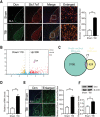Single-Nucleus RNA Sequencing Reveals that Decorin Expression in the Amygdala Regulates Perineuronal Nets Expression and Fear Conditioning Response after Traumatic Brain Injury
- PMID: 35038242
- PMCID: PMC8895134
- DOI: 10.1002/advs.202104112
Single-Nucleus RNA Sequencing Reveals that Decorin Expression in the Amygdala Regulates Perineuronal Nets Expression and Fear Conditioning Response after Traumatic Brain Injury
Abstract
Traumatic brain injury (TBI) is a risk factor for posttraumatic stress disorder (PTSD). Augmented fear is a defining characteristic of PTSD, and the amygdala is considered the main brain region to process fear. The mechanism by which the amygdala is involved in fear conditioning after TBI is still unclear. Using single-nucleus RNA sequencing (snRNA-seq), transcriptional changes in cells in the amygdala after TBI are investigated. In total, 72 328 nuclei are obtained from the sham and TBI groups. 7 cell types, and analysis of differentially expressed genes (DEGs) reveals widespread transcriptional changes in each cell type after TBI are identified. In in vivo experiments, it is demonstrated that Decorin (Dcn) expression in the excitatory neurons of the amygdala significantly increased after TBI, and Dcn knockout in the amygdala mitigates TBI-associated fear conditioning. Of note, this effect is caused by a Dcn-mediated decrease in the expression of perineuronal nets (PNNs), which affect the glutamate-γ-aminobutyric acid balance in the amygdala. Finally, the results suggest that Dcn functions by interacting with collagen VI α3 (Col6a3). Consequently, the findings reveal transcriptional changes in different cell types of the amygdala after TBI and provide direct evidence that Dcn relieves fear conditioning by regulating PNNs.
Keywords: amygdala; decorin; fear conditioning; perineuronal nets; traumatic brain injury.
© 2022 The Authors. Advanced Science published by Wiley-VCH GmbH.
Conflict of interest statement
The authors declare no conflict of interest.
Figures







References
-
- Rohling M. L., Binder L. M., Demakis G. J., Larrabee G. J., Ploetz D. M., Langhinrichsen‐Rohling J., Clin. Neuropsychol. 2011, 25, 608. - PubMed
-
- Stein M. B., Jain S., Giacino J. T., Levin H., Dikmen S., Nelson L. D., Vassar M. J., Okonkwo D. O., Diaz‐Arrastia R., Robertson C. S., Mukherjee P., McCrea M., Mac Donald C. L., Yue J. K., Yuh E., Sun X., Campbell‐Sills L., Temkin N., Manley G. T., Investigators T.‐T., Adeoye O., Badjatia N., Boase K., Bodien Y., Bullock M. R., Chesnut R., Corrigan J. D., Crawford K., Diaz‐Arrastia R., Dikmen S., et al., JAMA Psychiatry 2019, 76, 249. - PMC - PubMed
-
- Sah P., Neuron 2017, 96, 1. - PubMed
-
- Lepage C., Muehlmann M., Tripodis Y., Hufschmidt J., Stamm J., Green K., Wrobel P., Schultz V., Weir I., Alosco M. L., Baugh C. M., Fritts N. G., Martin B. M., Chaisson C., Coleman M. J., Lin A. P., Pasternak O., Makris N., Stern R. A., Shenton M. E., Koerte I. K., Brain Imaging Behav. 2019, 13, 725. - PMC - PubMed
Publication types
MeSH terms
Substances
Grants and funding
LinkOut - more resources
Full Text Sources
Medical
Miscellaneous
